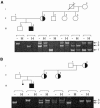A novel syndrome combining thyroid and neurological abnormalities is associated with mutations in a monocarboxylate transporter gene
- PMID: 14661163
- PMCID: PMC1181904
- DOI: 10.1086/380999
A novel syndrome combining thyroid and neurological abnormalities is associated with mutations in a monocarboxylate transporter gene
Erratum in
- Am J Hum Genet. 2004 Mar;74(3):598
Abstract
Thyroid hormones are iodothyronines that control growth and development, as well as brain function and metabolism. Although thyroid hormone deficiency can be caused by defects of hormone synthesis and action, it has not been linked to a defect in cellular hormone transport. In fact, the physiological role of the several classes of membrane transporters remains unknown. We now report, for the first time, mutations in the monocarboxylate transporter 8 (MCT8) gene, located on the X chromosome, that encodes a 613-amino acid protein with 12 predicted transmembrane domains. The propositi of two unrelated families are males with abnormal relative concentrations of three circulating iodothyronines, as well as neurological abnormalities, including global developmental delay, central hypotonia, spastic quadriplegia, dystonic movements, rotary nystagmus, and impaired gaze and hearing. Heterozygous females had a milder thyroid phenotype and no neurological defects. These findings establish the physiological importance of MCT8 as a thyroid hormone transporter.
Figures




Similar articles
-
Severe neurological abnormalities in a young boy with impaired thyroid hormone sensitivity due to a novel mutation in the MCT8 gene.Hormones (Athens). 2017 Apr;16(2):194-199. doi: 10.14310/horm.2002.1733. Hormones (Athens). 2017. PMID: 28742507
-
Pregnancy in women heterozygous for MCT8 mutations: risk of maternal hypothyroxinemia and fetal care.Eur J Endocrinol. 2011 Feb;164(2):309-14. doi: 10.1530/EJE-10-0679. Epub 2010 Nov 23. Eur J Endocrinol. 2011. PMID: 21098685
-
Prenatal Treatment of Thyroid Hormone Cell Membrane Transport Defect Caused by MCT8 Gene Mutation.Thyroid. 2021 May;31(5):713-720. doi: 10.1089/thy.2020.0306. Epub 2020 Sep 25. Thyroid. 2021. PMID: 32746752 Free PMC article.
-
Thyroid hormone transporters--functions and clinical implications.Nat Rev Endocrinol. 2015 Jul;11(7):406-17. doi: 10.1038/nrendo.2015.66. Epub 2015 May 5. Nat Rev Endocrinol. 2015. PMID: 25942657 Review.
-
Mechanisms of disease: psychomotor retardation and high T3 levels caused by mutations in monocarboxylate transporter 8.Nat Clin Pract Endocrinol Metab. 2006 Sep;2(9):512-23. doi: 10.1038/ncpendmet0262. Nat Clin Pract Endocrinol Metab. 2006. PMID: 16957765 Review.
Cited by
-
Mutations in MCT8 in patients with Allan-Herndon-Dudley-syndrome affecting its cellular distribution.Mol Endocrinol. 2013 May;27(5):801-13. doi: 10.1210/me.2012-1356. Epub 2013 Apr 2. Mol Endocrinol. 2013. PMID: 23550058 Free PMC article.
-
Thyroid Hormone Signaling in Oligodendrocytes: from Extracellular Transport to Intracellular Signal.Mol Neurobiol. 2016 Nov;53(9):6568-6583. doi: 10.1007/s12035-016-0013-1. Epub 2016 Jul 18. Mol Neurobiol. 2016. PMID: 27427390 Review.
-
Monocarboxylate transporter 8 expression in the human placenta: the effects of severe intrauterine growth restriction.J Endocrinol. 2006 Jun;189(3):465-71. doi: 10.1677/joe.1.06582. J Endocrinol. 2006. PMID: 16731778 Free PMC article.
-
Mct8-deficient mice have increased energy expenditure and reduced fat mass that is abrogated by normalization of serum T3 levels.Endocrinology. 2013 Dec;154(12):4885-95. doi: 10.1210/en.2013-1150. Epub 2013 Sep 12. Endocrinology. 2013. PMID: 24029243 Free PMC article.
-
Cellular and molecular basis of deiodinase-regulated thyroid hormone signaling.Endocr Rev. 2008 Dec;29(7):898-938. doi: 10.1210/er.2008-0019. Epub 2008 Sep 24. Endocr Rev. 2008. PMID: 18815314 Free PMC article. Review.
References
-
- Bernal J (2002) Action of thyroid hormone in brain. J Endocrinol Invest 25:268–288 - PubMed
-
- Bianco AC, Salvatore D, Gereben B, Berry MJ, Larsen PR (2002) Biochemistry, cellular and molecular biology, and physiological roles of the iodothyronine selenodeiodinases. Endocr Rev 23:38–89 - PubMed
-
- Bonen A (2001) The expression of lactate transporters (MCT1 and MCT4) in heart and muscle. Eur J Appl Physiol 86:6–11 - PubMed
Publication types
MeSH terms
Substances
Grants and funding
LinkOut - more resources
Full Text Sources
Other Literature Sources
Medical
Molecular Biology Databases

